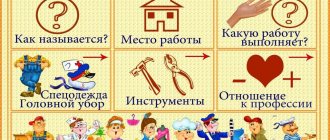How to talk about professions
There are many ways to learn about the world of different crafts with your children: coloring books, cartoons, books, conversations on a topic that interests the child.
It is important to remember that when describing a specialty you cannot express a negative attitude towards it. Your task is to make your stories interesting, understandable, and informative. Let preschool children draw their own conclusions about the advantages and disadvantages of different callings.
A story about the work of a mother, father or grandmother will be interesting to the child. Walking on the street you can see representatives of various professions: builders, janitor, driver, salesman, etc. The story about the peculiarities of the work of these people can be accompanied by a clear example.
An object of children's curiosity can also be some object made by a master: a beautiful carved stool, a forged candlestick or a glass vase. This beginning of the story, driven by a child's question, ensures that you will be listened to carefully.
Do not abuse time and convey the most interesting information. To justify such curiosity, it’s a good idea for parents to learn more about different specialties themselves. For children, information can be provided not only by their parents’ story, but also by other sources.
- Cartoons. Children of older preschool age will be interested in watching cartoons. You can download children's cartoons on the Internet containing descriptions of professions.
In them, kind fairy-tale characters will introduce preschoolers to people’s specialties in a playful way. Good cartoons with poetry were made back in Soviet times.
- Coloring pages. You can use coloring books from the age of four. While coloring pictures with your child, tell him about the work that is depicted. There are coloring books with poems.
- Images. Preschool children can be taught about crafts using themed pictures. The pictures may contain images of people of various specialties. The pictures can depict the workplace and tools of work of representatives of different professions.
- Games. For preschool children, games are the main means of familiarizing themselves with the surrounding reality. From about three years old, children are interested in playing, trying on different roles.
This can be used by supplementing stories about professions with game elements. You can play board games with children of senior preschool age: lotto, pictures linked to the alphabet, drawing puzzles, etc.
- Books. There are many great books for kids about different professions. These could be children's fairy tales or poems. Many of them can be downloaded for free on the Internet.
Assignments on the topic “Professions” for children aged 2-3 years
Task 1. Find a profession.
Goal: to connect work-related items with the profession itself; develop creative thinking skills.
Materials: cards with drawn objects that workers use. For each profession you must have at least two cards. Examples: a syringe, a white coat and a thermometer for a doctor, hair, scissors and a hairdryer for a hairdresser, a shovel, a dump truck for a builder.
Cards must be moved and placed face up. The child’s task is to combine all the interconnected cards and try to name the profession that unites them.
You can take a closer look at the pictures by simply clicking on them with the mouse. You can also print and cut the puzzles. To do this, click on the picture, right-click, select “save picture as,” save to your computer and print.
Task 2. Choose the odd one out.
Goal: to develop logical thinking and the ability to build associative connections.
Materials: cards specified in task 1.
An adult lays out several cards in a row. All but one must be tied to some profession. The child must identify the extra picture and try to explain the reason for this choice.
Tasks for children aged 4-5 years
Task 1. Who can name more?
Goal: develop communication skills; learn to react quickly to a situation.
Materials: small ball.
Two or more people sit in a circle. First, the adult throws the ball and at the same time names the specialty. The game continues until there are two left in the circle who still remember the unnamed specialties.
Task 2. Who does what?
Goal: learn to form nouns from verbs.
Materials: a pre-selected list of verbs from which the names of professions can be formed.
The adult names the verb, clearly pronouncing the syllables. The child tries to change it so that it becomes a specialty.
Examples of words: Teach - teacher. Drive - driver. Write - writer. Sing - singer. Carry - porter.
Task 3. What is he like?
Goal: to teach how to coordinate adjectives and nouns.
The adult names the profession, the child’s task is to describe it. If he fails, an adult can suggest an adjective, specifically indicating the wrong gender.
Examples: Teacher: kind, smart. Doctor: kind, attentive, responsible. Seller: polite, fast. Firefighter: brave, courageous.




